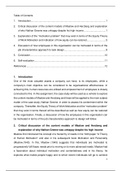Table of Contents
1. Introduction.............................................................................................................. 1
2. Critical discussion of the content models of Maslow and Herzberg and explanation
of why Nathan Greene was unhappy despite his high income ................................ 1
3. Explanation of the “motivation problem” that may exist in terms of the Equity Theory
of Work Motivation and indication of how equity can be restored ............................ 5
4. Discussion of how employees in this organisation can be motivated in terms of the
job characteristics approach to task design ............................................................. 8
5. Conclusion............................................................................................................. 10
6. Self-evaluation....................................................................................................... 11
References .................................................................................................................. 12
1. Introduction
One of the most valuable assets a company can have, is its employees, while a
company’s main objective can be considered to be organisational effectiveness. In
achieving this, human resources are utilised and empowerment of employees is closely
connected to this. In this assignment, the case study will be used as a vehicle to explore
the content models of Maslow and Herzberg and these will be applied to the main subject
matter of the case study, Nathan Greene, in order to assess his contentment within the
company. Thereafter, the Equity Theory of Work Motivation and the “motivation problem”
that may exist in terms thereof will be described as well as how equity can be restored
in the organisation. Finally, a discussion of how the employees in this organisation can
be motivated in terms of the job characteristics approach to design will follow.
2. Critical discussion of the content models of Maslow and Herzberg and
explanation of why Nathan Greene was unhappy despite his high income
Maslow first introduced his concept of a hierarchy of needs in his 1943 paper "A Theory
of Human Motivation" and also in his subsequent book Motivation and Personality
(Maslow,1943). In this, Maslow (1943) suggests that individuals are motivated to
progressively fulfil basic needs prior to moving on to more advanced needs. Maslow had
a fascination about individual motivation and contentedness and in his theory, he
explores what makes people happy and to which extent individuals will go to achieve
1
, this. Maslow believed that individuals’ ultimate desire is to be all that they can be, to be
self-actualised. For an individual to be self-actualised, Maslow described a few basic
needs that needs to be fulfilled first (Maslow,1943). These needs include psychological
needs, safety needs, love and belonging needs as well as self-esteem needs. If all of
these needs are progressively fulfilled, one reaches the self-actualisation need.
Maslow show these needs in the form of a hierarchy, where the most basic needs are
at the bottom of the pyramid and the more complex needs for an individual are displayed
at the top part of the hierarchy. Needs that are at the bottom of the pyramid, are basic
needs that a human requires. These include food, water and sleep (Maslow,1943). Once
these needs have been met, the individual can move up on the pyramid to safety and
love etc. The most basic of needs is that of psychological needs, these needs are vital
to the survival of individuals such as food, water, breathing and sleep. These basic
survival needs go along side basic needs of shelter and clothing.
Maslow’s model becomes increasingly complex as one moves up on the hierarchy
(Poston, 2009). At the second level of the hierarchy, an individual is in need of security
and safety. Individuals have the need to have control and order in their lives, thus the
need for security and safety becomes more apparent (Poston, 2009). At this level, you
can recognise and point out differences in human behaviour between different
individuals. Needs on this level of the hierarchy also include financial security, health
and wellness as well as safe human behaviour. Behaviour that one would typically see
in individuals on this level, is obtaining a secure employment position, a home that is
safe for family as well as a secure life insurance. These behaviours are all motivated by
the safety and security needs of an individual (Maslow, 1943).
As one moves up along Maslow’s hierarchy model, the need for love and acceptance
can be found on level 3 of the hierarchy and at this level, the need for emotional
relationships drive human behaviour. Individuals at this level have the need for
acceptance and belonging. Other needs that also satisfy individual motivation on this
level, include the forming of friendships, romantic attachments, the joining of social
groups as well as attending religious ceremonies. Individuals have the need to form
relationships with other individuals to avoid psychological disorders such as depression
and anxiety (Lee and Robbins, 1998). This behaviour can also be said to fuel individual
motivation.
On the fourth level of Maslow’s hierarchy, one finds the need for self-esteem.
Appreciation and respect are included on this level. Self-esteem plays a prominent role
2




